
The peppered moth is a temperate species of night-flying moth. It is mostly found in the northern hemisphere in places like Asia, Europe and North America. Peppered moth evolution is an example of population genetics and natural selection.

The tawny speckled pug is a moth of the family Geometridae.
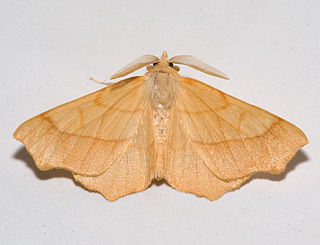
Ennomos quercinaria, the August thorn, is a moth of the family Geometridae. The species can be found in Europe. It was first described by Johann Siegfried Hufnagel in 1767.
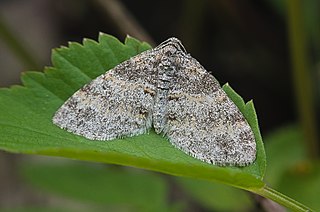
Lobophora halterata, the seraphim, is a moth of the family Geometridae. It was first described by Johann Siegfried Hufnagel in 1767. The species can be found in central and northern Europe and a few localities in southern Europe, Siberia, Amur, Primorye, Sakhalin and Japan.

Plagodis pulveraria, the barred umber, is a moth of the family Geometridae. The species was first described by Carl Linnaeus in his 1758 10th edition of Systema Naturae. It is found throughout much of the Palearctic realm from Ireland to Japan, and in the Nearctic realm (Canada).

Idaea straminata, the plain wave, is a moth of the family Geometridae. It is found in Europe including West Russia and Balkans.
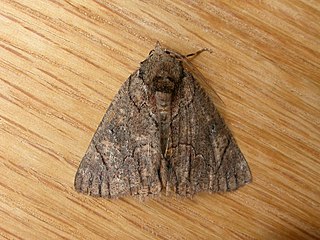
Heliomystis is a monotypic moth genus in the family Geometridae. Its only species, Heliomystis electrica, the electric moth, is found in the southern half of Australia. Both the genus and species were first described by Edward Meyrick in 1888.
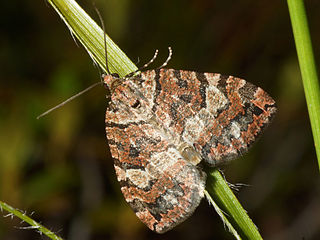
Hydriomena furcata, the July highflyer, is a moth of the family Geometridae. The species was first described by Carl Peter Thunberg in 1784. It is found in the Holarctic ecozone.

Philereme transversata, the dark umber, is a moth of the family Geometridae. It is found in much of the Palearctic realm.

Maxates centrophylla is a moth of the family Geometridae. It is known from Australia, including Tasmania.

Mnesiloba dentifascia is a moth of the family Geometridae first described by George Hampson in 1891. It is known from the Oriental tropics.
Ziridava xylinaria, the indistinct carpet, is a moth in the family Geometridae. The species was first described by Francis Walker in 1863. It is found in Sri Lanka, India, Hong Kong and on Peninsular Malaysia, Borneo, Java and possibly the Philippines and Sulawesi.
Collix hypospilata is a moth in the family Geometridae. It was described by Achille Guenée in 1857. It is endemic to Sri Lanka.
Eois nigriceps is a moth in the family Geometridae. It is found in Peru.
Eois perstrigata is a moth in the family Geometridae. It is found in Peru.
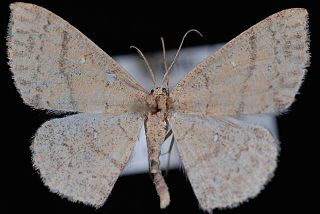
Cyclophora dataria is a moth in the family Geometridae. It is found in North America, from British Columbia to California, east to Arizona and north to Montana. The habitat consists of mixed or deciduous woods with Quercus species.
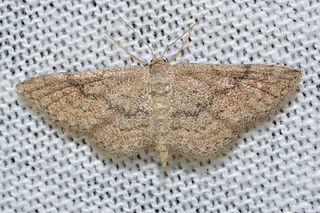
Lobocleta ossularia, the drab brown wave moth, is a moth in the family Geometridae. It is found in North America, where it has been recorded from California to Florida, north in the east to New York and Illinois.

Euchlaena marginaria, the ochre euchlaena moth, is a moth of the family Geometridae. The species was first described by Charles Sedgwick Minot in 1869. It is found in North America, where it has been recorded from south-central British Columbia and Idaho to Nova Scotia and south to Florida and Missouri. The habitat consists of mixed wood and deciduous forests.

Lobocleta peralbata is a moth in the family Geometridae. It is found in North America, where it has been recorded from Arizona to Florida, north to North Carolina.
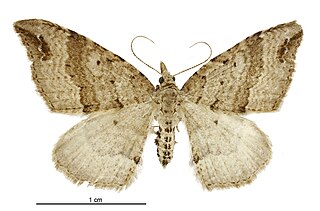
Homodotis falcata is a moth of the family Geometridae. It is endemic to New Zealand and is found in the southern part of the South Island. The larvae of this species feed on leaf litter and adults are on the wing for most months of the year. The forewings of this species can vary in depth of colour.















